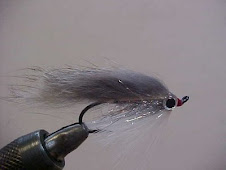Jig Hooks for Bead Heads
by | May 29th, 2015
Jig hooks help your fly swim hook point up, and avoid snagging the bottom or dulling the hook point.
Some new techniques and materials come onto the fly-tying scene with a bang, and others just materialize slowly over time, becoming more and more common until one day you look at something and say “Where the heck did that come from, and why didn’t I notice it earlier?”
Using jig hooks for flies has been around for a long time now, but there has certainly been a surge in their popularity in just the past few years. It seems this is one more thing the rest of us borrowed from the international competitive fly-fishing crowd, where beadhead flies with jig hooks have been trophy winners for quite a number of years.
There are a number of manufacturers with jig hooks for trout including Tiemco, Umpqua, Hanak, Partridge, Dohiku, and Knapek to name a few. With the hook eye situated on an upright, in-line position in relation to the hook shank, with angles varying from 60 to 90 degrees, most of these modern jig hooks are barbless, with long points to accommodate the regulations of international competition. Many of these hooks are finished in a sexy black nickel finish and all have ridiculously sharp needle points. They are as deadly as they look.
Given the upright front end of the shank, jig hooks also require specifically designed, slotted beads to accommodate this shape. Most are tungsten in gold, black, copper, and silver, as well as smooth and faceted finishes.
When I think of competitive fishing and flies tied on jig hooks, one Western angler immediately jumps to my mind and that is Utah’s own Lance Egan. Lance is a longstanding member of Team USA and one of our country’s few medal winners in international competition. He’s also the host of the Fly Fisherman instructional DVD series Nymphing Foundations and Expert Tactics (flyfisherman.com/store). He’s also a signature tier for Umpqua Feather Merchants, and because of that, his flies haven’t just impacted the competitive circuit, they have impacted the fly-tying minds of every fly fisher who browses through a fly shop.
Lance is an incredibly humble guy in a world where he has every right to brag. A self-described fly-fishing junkie, Lance never passes up a chance to learn a new technique or hone his skills on any given piece of water, and his track record in competition speaks to this.
With this in mind, I called Lance to get his insights and thoughts on the jig hooks we’re seeing today, and his answers were thoughtful and clearly practiced. Lance explained that one of the most obvious advantages of jig hooks is that they ride hook point up, and resist snagging on the bottom, a consideration of large importance for competitive anglers. Losing flies costs precious time in competitions, so anything that can keep you fishing and not re-rigging is a big advantage.
Lance went on though, to explain that the biggest advantage of jig nymphs is that they reliably hook the fish right in the tip of the snout, rather than in the bottom jaw or side of the mouth. He says this is a better spot for barbless hooks, because it better allows you to direct and lead the fish and quickly land them, “like a bull with a nose ring.”
I can’t say that I ever thought of that particular advantage on my own, but once Lance brought it up, a string of memories flashed through my brain and you know . . . he’s right. I would have guessed that the long, barbless points of these competition hooks simply penetrated deeper and held better than conventional hooks, but after considering Lance’s view, I’d have to agree. The corner of the jaw is secure, but with a big fish in particular, it leaves a lot of fight in the fish because the trout can turn its head and use the current to its advantage.
Lance ties his patterns with tungsten beads and typically weights them with lead wire as well to keep them tight to the bottom. His Frenchie and Iron Lotus patterns are both on jig hooks so I asked him to expound a bit on their designs. While the Frenchie is tied “in the round,” that is, the same when viewed from any angle and lacking a wing case or definite topside, the Iron Lotus sports a wing case on the top of the shank.
When I questioned him about why he would tie the fly upside down like this, he explained that the fly doesn’t always hang precisely horizontal but rather at a bit of an angle, and tying the fly with the wing case on the top of the shank shows it directly to the fish as the fly drifts. I think this guy may have fins.
Egan told me the only disadvantage he’s seen using jig hooks was when fishing streamers, specifically in lakes, with a fast retrieve. Dead drifting or slow retrieves seem to get regular hook-ups, but he notices a distinct drop-off in hook-ups when fast stripping the fly. Perhaps there’s something to the upright angle of the hook eye that prohibits the fish from getting pinned on a fast retrieve, or perhaps Egan just has bad luck, but I’d bet he will have this puzzle figured out long before the rest of us even find the pieces.
Now I have not seen this when I have use them, the streamers that I make I bend the hook point up just a little, and this increases hook ups as the fish's mouth cannot ride over the hook point.
Now I have not seen this when I have use them, the streamers that I make I bend the hook point up just a little, and this increases hook ups as the fish's mouth cannot ride over the hook point.












No comments:
Post a Comment